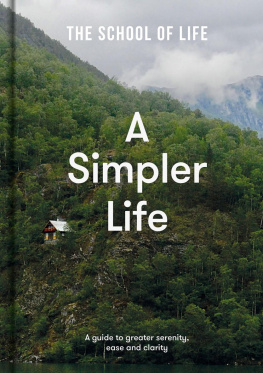Ryan Bartaby - A Simpler Life
Here you can read online Ryan Bartaby - A Simpler Life full text of the book (entire story) in english for free. Download pdf and epub, get meaning, cover and reviews about this ebook. publisher: The School of Life, genre: Home and family. Description of the work, (preface) as well as reviews are available. Best literature library LitArk.com created for fans of good reading and offers a wide selection of genres:
Romance novel
Science fiction
Adventure
Detective
Science
History
Home and family
Prose
Art
Politics
Computer
Non-fiction
Religion
Business
Children
Humor
Choose a favorite category and find really read worthwhile books. Enjoy immersion in the world of imagination, feel the emotions of the characters or learn something new for yourself, make an fascinating discovery.
- Book:A Simpler Life
- Author:
- Publisher:The School of Life
- Genre:
- Rating:4 / 5
- Favourites:Add to favourites
- Your mark:
- 80
- 1
- 2
- 3
- 4
- 5
A Simpler Life: summary, description and annotation
We offer to read an annotation, description, summary or preface (depends on what the author of the book "A Simpler Life" wrote himself). If you haven't found the necessary information about the book — write in the comments, we will try to find it.
A Simpler Life — read online for free the complete book (whole text) full work
Below is the text of the book, divided by pages. System saving the place of the last page read, allows you to conveniently read the book "A Simpler Life" online for free, without having to search again every time where you left off. Put a bookmark, and you can go to the page where you finished reading at any time.
Font size:
Interval:
Bookmark:

A Simpler Life
The School of Life
A guide to greater serenity, ease and clarity
Simplicity has become, for many of us, a word filled with longing and desire. We long to unburden ourselves of excess, to have more straightforward relationships, to declutter our homes and to avoid noise, complexity and fuss. Simplicity has grown central to our vision of happiness.
But it is notable and revealing that in historical terms, this yearning is very new. For most of our time on this planet, our aspirations have pointed in a radically different direction. Traditionally, whenever the chance arose, peoples instincts ran towards enrichment and complexity; we wanted to embellish our environment, to demonstrate increasing sophistication and to live with greater opulence, formality, ritual and display.
A dramatic example of the movement away from this pattern of behaviour and towards a love of simplicity can be seen in the story of one particular clan.
Some time in the 1830s, a far from prosperous family moved into a very plain and modest farmhouse in New York state. They didnt select the house because they admired its rustic charms or because they were attracted to the stark angularity of its design. Their motivation was entirely pragmatic: it was affordable on their very limited budget. They lived simply not by choice but as many people had always done out of necessity.
It was in this house that, in 1839, the familys second child was born. He was named John Davison, and the family name was Rockefeller. This boy, known to most as J.D. Rockefeller, went on to make one of the greatest fortunes in economic history, founding in 1870 the Standard Oil Company, which at its peak held a near-monopoly on oil production in the USA. By his mid-fifties, Rockefeller had done what people throughout history had done when they had the opportunity: he bought land and set about building a triumphal mansion a fabulously luxurious and ornate classical palace, with an imposing symmetrical faade topped by a stone statue of an eagle.

John Davidsons family home, Richford, New York State, USA

Kykuit, the J.D. Rockefeller Estate, Sleepy Hollow, New York State, USA, 1913
However, just a couple of generations later, when J.D.s grandson (David Rockefeller, who now controlled much of the vast family fortune) built his own house, he went a very different way. David commissioned one of Americas leading modernist architects, Philip Johnson, to build him a spartan minimalist base in Manhattan.

Philip Johnson, Rockefeller Guest House, Manhattan, USA, 1950
Though it sits on a very valuable piece of land, the exterior of the house is extremely restrained and its entrance almost humble. The internal spaces are white and unadorned: the concern throughout was for extreme serenity and simplicity.
David Rockefeller had every possible option open to him: he could have built something vast and swaggering, but what he really craved like so many inhabitants of the modern world was modesty and informality. Simplicity had stopped being a forced necessity to be escaped from at speed: it had become a philosophy to be aspired to.

Attributed to Antonio Rodriguez, Portrait of Moctezuma II, 16801697
The same journey from complexity to simplicity can be traced in the development of a multitude of social and material trends, for example, in clothing. From the very beginning of recorded history, anyone of status and wealth tried to convey their position via the richness and splendour of what they wore.
No Aztec emperor would have dressed in clothes like those of his ordinary subjects; the uniform of a general was always more magnificent than that of a common soldier; a princess could never dress like a serving girl. But in modernity, there has been a radical shift. Today, those of great standing and power often opt for the simplest wardrobes.

Steve Jobs, former CEO of Apple Inc.
Similar transitions have taken place with our eating habits. As soon as our ancestors had the option, they devised separate dining rooms, where the eating of meals could be distanced from their preparation. If money was tight, the kitchen might be tiny and the dining room minute but the separation was key. Only servants, farm labourers and factory workers ate in the kitchen. This trend continued for millennia. But in recent times, weve gladly chosen to return to the situation that earlier ages were desperate to flee.

The Sitting Woman and The Thinker, Hamangia culture, c. 5000 BCE
We see this in art, too. In 1956, a number of small clay statues dating from c. 5000 BCE were unearthed near the border between Romania and Bulgaria. Their faces and limbs are crudely modelled; theres no sign that the people who made them had the ability to reproduce the precise shape of a finger or of the muscles in a leg. The figures were simple because that was all they could manage.

Michelangelo, terracotta model for the Piet, c. 14731496
Over succeeding millennia, sculptors went on to develop extraordinary technical capacities. In the late 15th century, Michelangelo produced a small-scale terracotta statue of Mary, the mother of Jesus, with her dead son lying across her lap, as a preparatory study for a much larger marble version known as the Piet. In the model, every limb is astonishingly accurate and the delicate modulation of bone, muscle and skin around each ankle or knee is perfectly rendered.
However, by the 1930s, the British sculptor Henry Moore had become famous for his crudely rendered figures, greeted as masterpieces by the prominent critics of the age.

Henry Moore, Reclining Woman, 1930
Technically, Moore was well able to reproduce the complex shapes of an elbow or a wrist. But he had chosen not to.
It was useful that the ancient clay figures from the RomanianBulgarian border were discovered in 1956 when they could be recognised as powerfully expressive masterpieces rather than in 1456 (or indeed 1856) when they would have been dismissed as bizarre curios, interesting only as evidence of the incapacity of primitive people to create genuine works of art. We rediscovered them just as our taste for simplicity could help us to perceive their beauty.
Font size:
Interval:
Bookmark:
Similar books «A Simpler Life»
Look at similar books to A Simpler Life. We have selected literature similar in name and meaning in the hope of providing readers with more options to find new, interesting, not yet read works.
Discussion, reviews of the book A Simpler Life and just readers' own opinions. Leave your comments, write what you think about the work, its meaning or the main characters. Specify what exactly you liked and what you didn't like, and why you think so.












